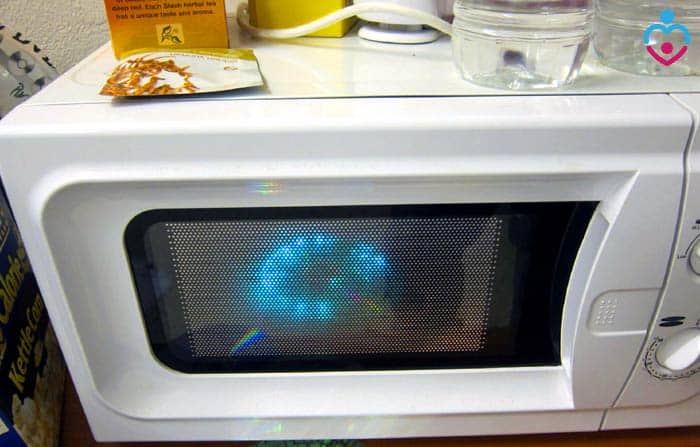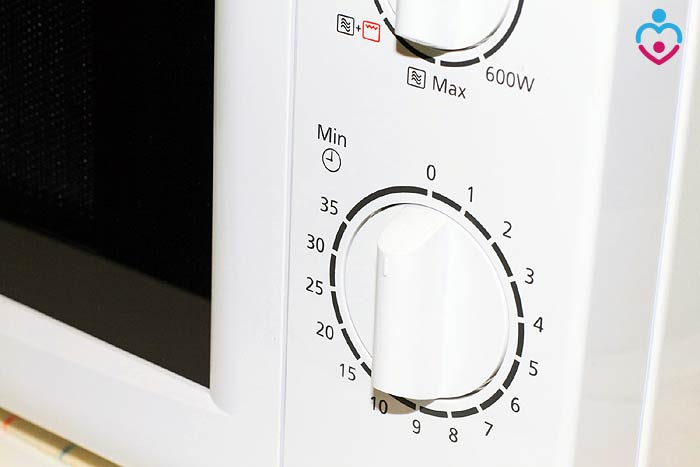
Heating breastmilk is no walk in the park. Especially when you are in a hurry, and you don't have the time to get it to the exact temperature your baby prefers.
So, you might wonder if you can use the miracle device known as the microwave. It sounds very convenient and easy to just place the bottle in the microwave and give it one minute or less to heat up. But should you do that?
Jump to:
Why can't you microwave breast milk?

No, you should never heat breastmilk in the microwave. As tempted as you might be to do that, this is not an option in any circumstances.
- The main reason is that the microwave will not heat the milk evenly. Because of this, the milk can scald your baby as they drink it even if the bottle doesn't seem to be too hot.
- Heating milk in the microwave will also take away a significant amount of nutrients. So much heat at once will damage the protein and nutrients in the milk. It will offer proper conditions for bacteria to grow because the temperature of the milk will rise in seconds, which is way too fast to be safe.
- Also, freshly expressed milk contains a high level of immune properties and factors. You want to conserve these immunological qualities of the milk as you store it correctly. But by exposing breastmilk to microwave heat, you will destroy most of these properties that will not resist such a sudden temperature change.
As you can see, there are plenty of reasons why you shouldn't heat up the milk in the microwave. And, as side advice, you shouldn't use the microwave too often for your food either. Better to take the long route when it comes to heating up your baby's next meal!
Can you use the microwave to heat other types of milk?

However, you might wonder if heating up regular milk in the microwave is safe for your baby. Unfortunately, pediatricians don't recommend using the microwave at all for any milk or food that will end up in your baby's tummy.
- The reasons are the same as those that should stop you from using the microwave for breastmilk. But, some parents choose to use the microwave for heating up cow milk or other types of baby food, and the opinions are split.
- If, when it comes to breastmilk, the microwave is a definite "no", for other types of milk, it will be up to each parent and the risks they consider to take.
- But you should always remember that the microwave will take away the nutrients in all types of milk and food. It will also give hot spots, and you are safer if you avoid this for your baby's sake!
- When it comes to bacteria, the concerns are less for cow milk or another type of milk, compared to breastmilk. So, the microwave will not increase the bacteria in the milk as much because cow milk has a higher resistance than breastmilk to bacteria. But the other concerns remain the same.
Top 4 ways to thaw your breast milk

So if the microwave oven isn't an option for warming up breast milk, what is the best way to thaw the breast milk. Breast Milk can be warmed up in several ways. Slow and gentle thawing is best to preserve and maintain the healthy nutrients of breast milk.
- One of the best options is to let it thaw in the refrigerator overnight. This technique saves the fat nutrients of the milk.
- The next option is to bring the water to a lukewarm state and then turn off the stove or microwave oven. Let it sit on the counter for a couple of minutes, and then let the cold bottle sit in it to thaw slowly. Make sure that it is not HOT water.
- The third option to thaw human milk is to rotate the breast milk bottle in warm water continually. Once the milk is thawed, ensure that the baby uses it within 24 hours.
- The last option is to use the best bottle warmer for frozen breast milk.
The microwave might be your go-to device when you need to heat your food. But that doesn't mean it is entirely safe for you or your baby.
This device doesn't use a flame to heat the food, and therefore, it alters it with different waves that might damage it more or less.
You want your baby to get the best food every meal, and the microwave is definitely not a good option for that!
![]()







Leave a Reply